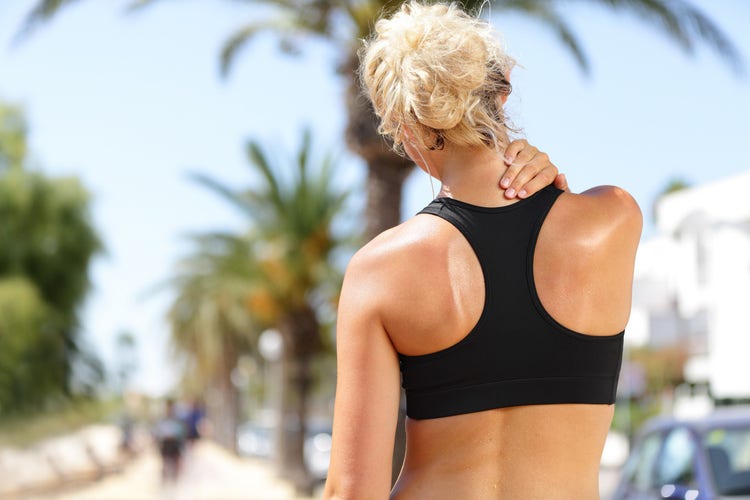The Science Behind Sore Muscles

Here’s why your muscles are sore after you work out and what you can do about it.
Whether you’re new to working out or a seasoned athlete, muscle soreness can happen to you. From running and cycling to kickboxing and even yoga, no muscle is off limits when it comes to soreness post-exercise. So, why do muscles get sore after activity?
What is DOMS?
Intense soreness that comes on up to two days after an intense workout or new regimen — otherwise known as DOMS or delayed onset muscle soreness — is normal, and a sign that you’re improving your fitness. You’re most likely to experience DOMS when beginning a new workout routine, trying out a new form of exercise, working out for longer durations or working out more strenuously than usual. That soreness can last from three to five days.
While any movement can result in DOMS, running or jogging downhill and any movements such as push-ups, squats or deadlifts that entail lowering a load to the ground are more likely to cause soreness. Also, movements that result in the muscle lengthening — called eccentric muscle contractions — cause more soreness than others, says the National Health Service. If you’re sore, don’t worry. As you make progress and acclimate to rigorous activities, your muscle soreness will drastically decrease. Don’t let a little soreness dampen your enthusiasm for working out.
What are muscle aches?
While DOMS isn’t completely understood today, most professionals agree on its cause: When your muscles are required to work harder than normal, microscopic damage to your muscle fibers occurs. With this microscopic damage comes stiffness and soreness.
Medical and sports experts formerly believed DOMS was caused by a build-up of lactic acid. However, these experts now conclude that lactic acid is gone from your muscles within 60 minutes after your workout. Regardless, it’s important to replace the energy spent during a workout session, so your body can repair the damaged muscle proteins. Do this with water, amino acids and proteins.
Mild soreness is normal the day after a good workout. It usually lasts between one and three days, and it’s a sign you’ve triggered muscle growth. When you adapt to a workout and are no longer a bit sore afterward, you should adjust the intensity or weight so you can continue to improve muscle strength.
DOMS differs from this mild soreness in that it is a much deeper, longer-term soreness that prevents muscles from fully contracting. BreakingMuscle.com reports that a combination of active and passive recovery (either doing something to help or doing nothing at all, respectively) is recommended to alleviate.
Regardless of your intensity of soreness, Pete McCall of Institute of Motion say the most effective thing is “to allow for stretching [or self-myofascial care] at the end of a workout.” He states that a gradual cool-down helps to reduce metabolic waste in the muscles. In addition, he recommends staying hydrated to keep the circulatory system effective at removing waste from tissue.
How to minimize DOMS
In order to minimize muscle soreness, take a gradual approach to your new physical exercise routine. A slow and steady approach will give your muscles plenty of time to adapt to the new physical movements.
According to the American Council on Exercise, people who are interested in lifting weights should start their workout with light weights, working out up to three times each week. Once the body has built up a tolerance to the weight, you should gradually increase the weight after a month or two. Respect your limits and you’ll likely decrease DOMS.
McCall recommends alternating days of high and low intensity as well.
Ways to soothe sore muscles
Give it time. You won’t have sore muscles forever. Until the soreness is gone, ease the pain with ice. Massage and tender-point acupuncture are effective as well. Additionally, anti-inflammatory medications, including ibuprofen and aspirin may be able to ease some of your symptoms, though these should be taken sparingly.
Most cases of DOMS do not require the attention of a doctor. However, DOMS and muscle strain often have similar symptoms. Don’t neglect the pain if you think you may have an exercise-related injury. If you suspect you do have an injury, seek treatment from a medical professional or follow the RICE method (rest, ice, compression, elevate) at home.
Muscle rubs or a visit to the sauna before a workout can elevate tissue temperature and prepare the tissue for the physical demands of your workout. Ice afterwards helps to reduce inflammation and soreness.
How to eat for recovery
A few foods and spices in your cupboard can actually help soreness and speed the recovery process. For instance:
- Curcumin, the bright orange-colored molecule found in turmeric, can reduce pain. A 2015 study published in the “European Journal of Applied Physiology” found that men experiencing severe leg muscle pain who were treated with curcumin saw a reduction in pain.
- Nutrient powerhouses like berries, cherries and plums help eliminate waste in the muscles.
- Leafy greens reduce inflammation, lower cortisol levels and improve hydration.
- Watermelon, potatoes and pineapple are all high on the glycemic index. These foods replenish glycogen in your muscles to aid in tissue repair.
- Salmon, almonds and eggs are all solid sources of good-for-you protein. Almonds have been shown to accelerate repair of damaged tissue.
And, of course, don’t forget to hydrate. The Food and Nutrition Board recommends women consume 2.7 liters (91 ounces) of water each day. Active individuals need even more.
From fitness novice to expert, anyone can experience muscle soreness. Follow these tips, eat a balanced diet and don’t let a little soreness keep you from working hard toward your fitness and health goals.